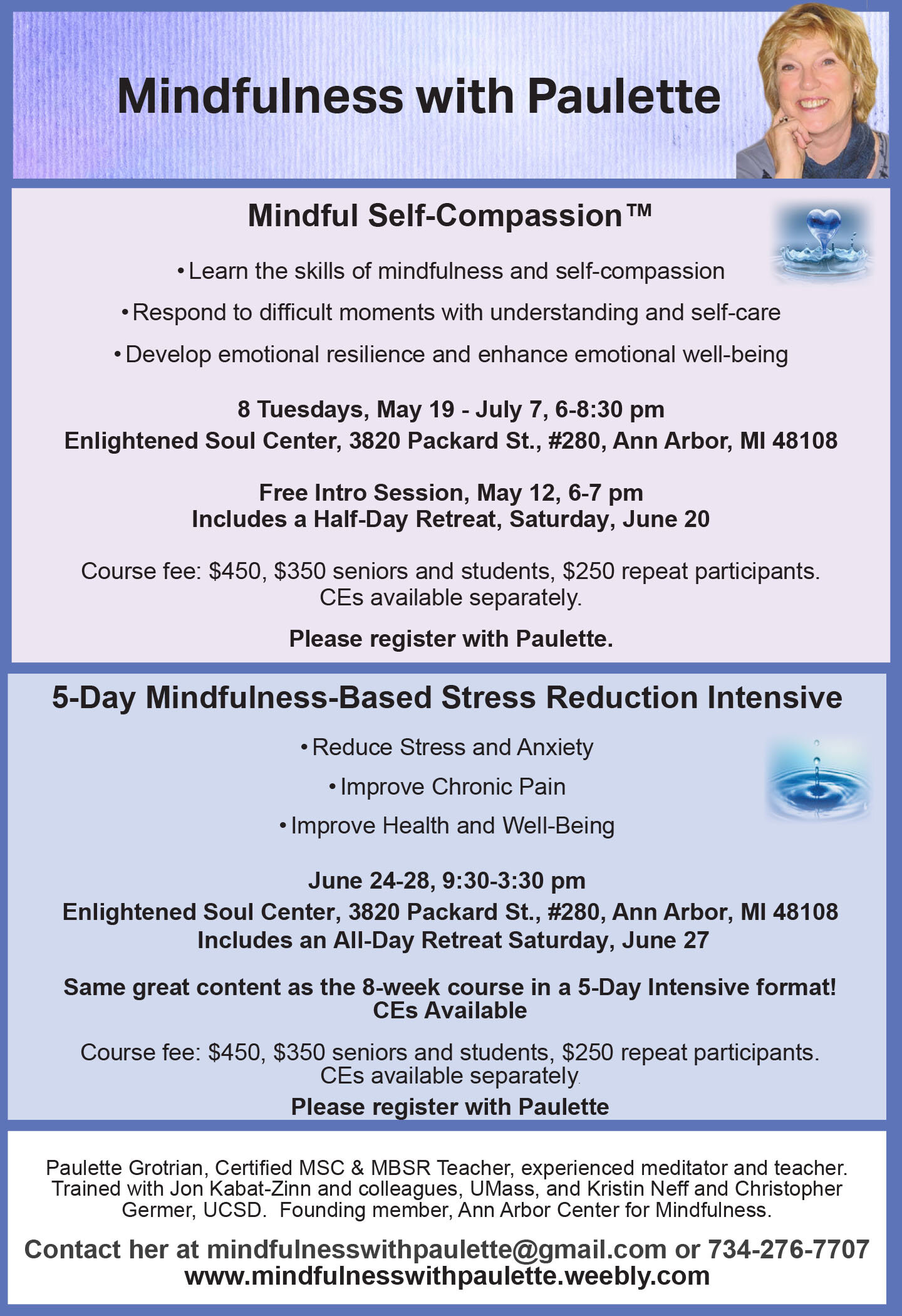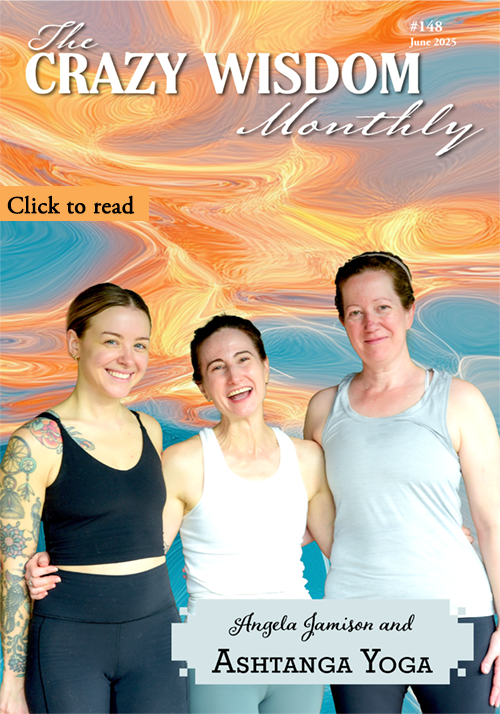By Katie Hoener
Namaste, Katie,
Over the cold months, I feel like I am frequently scrunching my shoulders toward my ears, and my ears toward my shoulders. My shoulders and my chest feel tight as a result. I try to pay attention, and relax when I can. Is there a particular posture that I could add to the end of my day to assist with relaxing these areas?
Gina, Dexter
Namaste, Gina,
This is a common concern for many in our Michigan winters. As the weather changes from moment to moment on some days, we carry a lot of that anticipation and reaction, and hold that tension within the body. As you mentioned, common places to hold stress in the body are the shoulders, the chest, and not specifically stated, the neck. Though we all have ‘hot spots’ in the body where tension loves to hang out, these are common areas for a large number of Michiganders.
One particular asana that may be useful to you in the cold months to relieve tension is Dhanurasana, or Bow Pose. This posture has many benefits, one of which is to release the front of the shoulders, chest, and neck. In addition to these openings, Bow Pose strengthens the back, and uses the breath, with contact with the floor, to massage the organs.
To come into Dhanurasana, lay on your mat (or the floor) face down. You may wish to come into a Crocodile Pose in between sides, if you are choosing to take a Half Bow, and move from one side to the other. Let’s start with this option. Gently find the right foot with the right hand, feel free to use a prop, such as a strap, if that is a safe choice for your body. On an inhale, press the foot into hand, and float the chest off the floor. Allow the neck to remain neutral, so the gaze will stay on, or near, the floor. Allow the shoulder blades to reach down the back as you engage the glutes and the muscles of the lower back. Breathe deeply, and see if you can notice the movement of the abdomen along the floor or mat. Gently lower down, and rest on one side of the face, or return to Crocodile Pose. Take a few breaths here until you are ready to move to the other side.
Another option is to take a full Dhanurasana, where both feet come to the hands at the same time. In this variation of Bow Pose, we press both feet into the hands, and want to make sure the knees are magnetizing toward one another to help with stabilizing the pelvis. Find the right amount of lift that makes the shoulders feel open and the spine feel long. After a few connected breaths, lower yourself down, and find a resting space.
Namaste, Katie,
I have been taking meditation classes, and yoga when I can, and I understand that ‘yoga is the quieting of the mind.’ I struggle at times to explain this idea to my friends and family. Do you have any tips?
Steve, Ann Arbor
Namaste, Steve,
You are not alone in recognizing this challenging concept! When we discuss “yoga citta vritti nirodhah” we discuss the calming of the modifications of the mind, or the mind-stuff. You are absolutely right that translating mind-stuff can be a daunting proposition. Michael Singer’s The Untethered Soul does a lovely job of describing this chatter of the mind. He opens his book describing these modifications as an “Inner Roommate.” Michael Singer states that this inner roommate comments on all that we do, and narrates every moment that we have.
This, plus all of the external stimuli that we interact with on a daily, even momentary basis, are a portion of what makes up the mind-stuff. We add to that memories, plans, and thought patterns, and the mind becomes a busy place to be in, much less a place of rest. If we can think of this “inner roommate” narration, as additional fluctuations of the mind, we can begin to make sense of what we are working with. Not only are we trying to quiet the thoughts, we are working to quiet the response to the thoughts! This is not an easy task, and yet the process begins one minute at a time.
Read related article: A 24-Hour Yoga Practice
As we have tried to develop throughout this column, and we will continue to do so, yoga is meditation. This quieting of the mind that you so beautifully bring forward, is the essence of our practice, our mission statement so to speak. So, perhaps we start with one minute of meditation each day, and build from there to a place that feels comfortable within our lives. Best of luck with your inner roommate.
Namaste, Katie,
In a class recently, we did a breath practice that involved the arms moving up, and out to a “T” and then overhead. It was lovely, and I don’t recall the name, or much about it, as it came and passed rather suddenly in the practice. Do you recognize this and can you tell me more?
Sandy, Ann Arbor
Namaste, Sandy,
I think that I do! If I am way out of sorts, let me know, and we’ll try something else next issue. I believe that you are speaking of Breath of Joy. This Pranayama practice is an invigorating practice that awakens heat and fire in the body, while the forceful exhale and forward fold provides a space for release. Breath of Joy is used in many varieties of asana practice, as it is emotionally uplifting and offers balance to the body.
To come into Breath of Joy, start in Tadasna or Mountain Pose. During the first third of your inhale bring the arms up to about shoulder height, in front of your body. The next third of the inhale takes the arms out to the “T” position you mentioned, and the last third of the breath takes the arms overhead. The exhale is a forceful release while folding into and Uttansana, a Forward Fold. One point on the Forward Fold; take that fold as deep, or as soft as feels good. For those of us with blood pressure issues, a full fold may be too much. This is also a breath practice that is best to ease into, start with three rounds of the breath, and if it feels like a safe and healing space, the next time, try five breaths and so on. See what joy you can find in this breath today!
Katie Hoener is an RYT 500, receiving her 200 and 500 hour trainings. She is also a Licensed Master Social Worker and a partner at Verapose Yoga in Dexter (veraposeyoga.com).Please send your own yoga questions to katie@veraposeyoga.com.
Related Articles:





























































































































































































For the last 15 years, in the early morning between five and eight, the 200 block of South Main Street has filled with yoga practitioners who come and go before the town comes to life. It’s a diverse group, ranging from those in their teens to those in their 80s, across all sorts of life situations and physical capacities. The yoga they practice is tailored to the individual. Depending on the person, the practice might include various physical asanas, breathing techniques, and meditations. What they all have in common is that they’re all part of a school, and a community organization, called Ashtanga Yoga Ann Arbor.